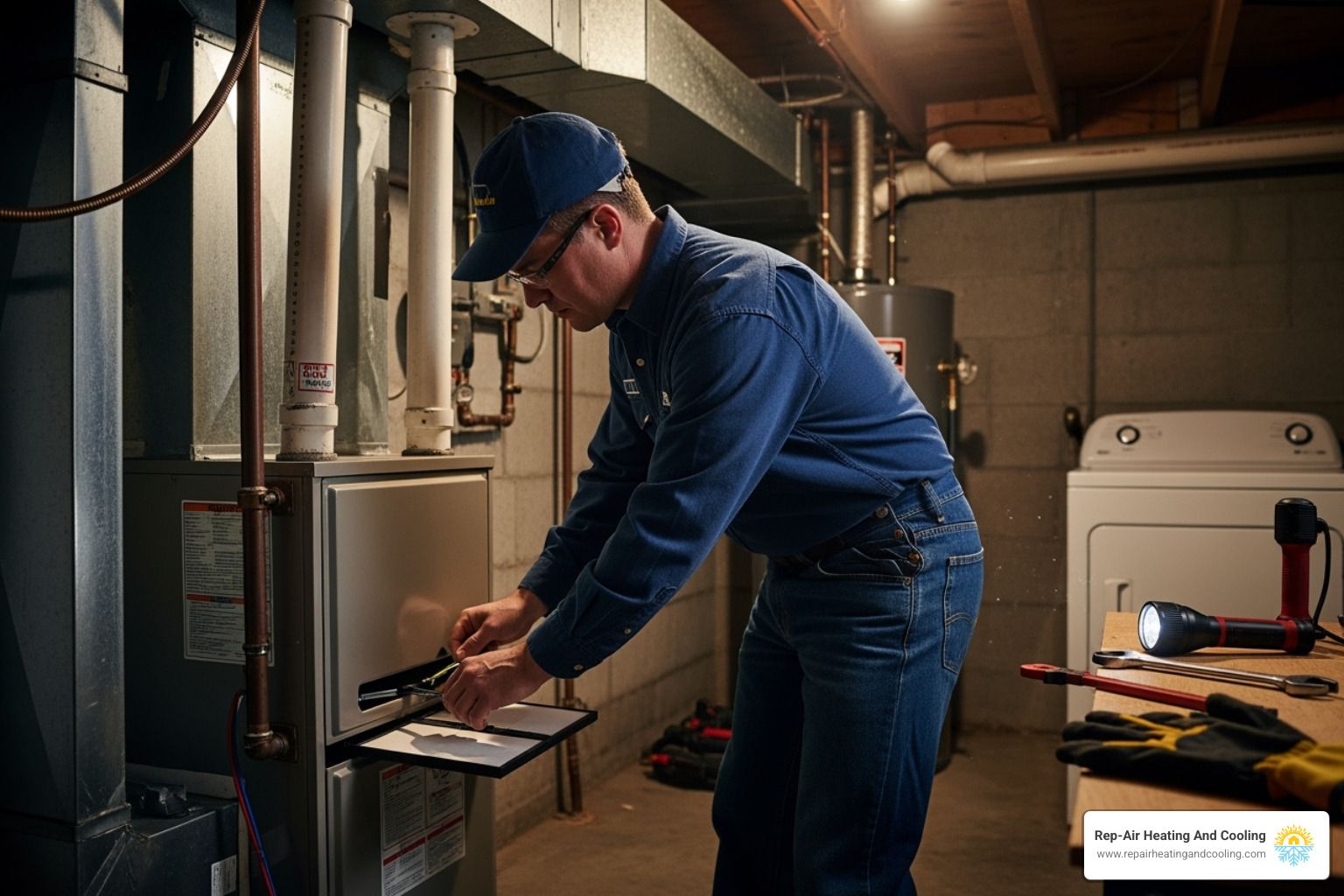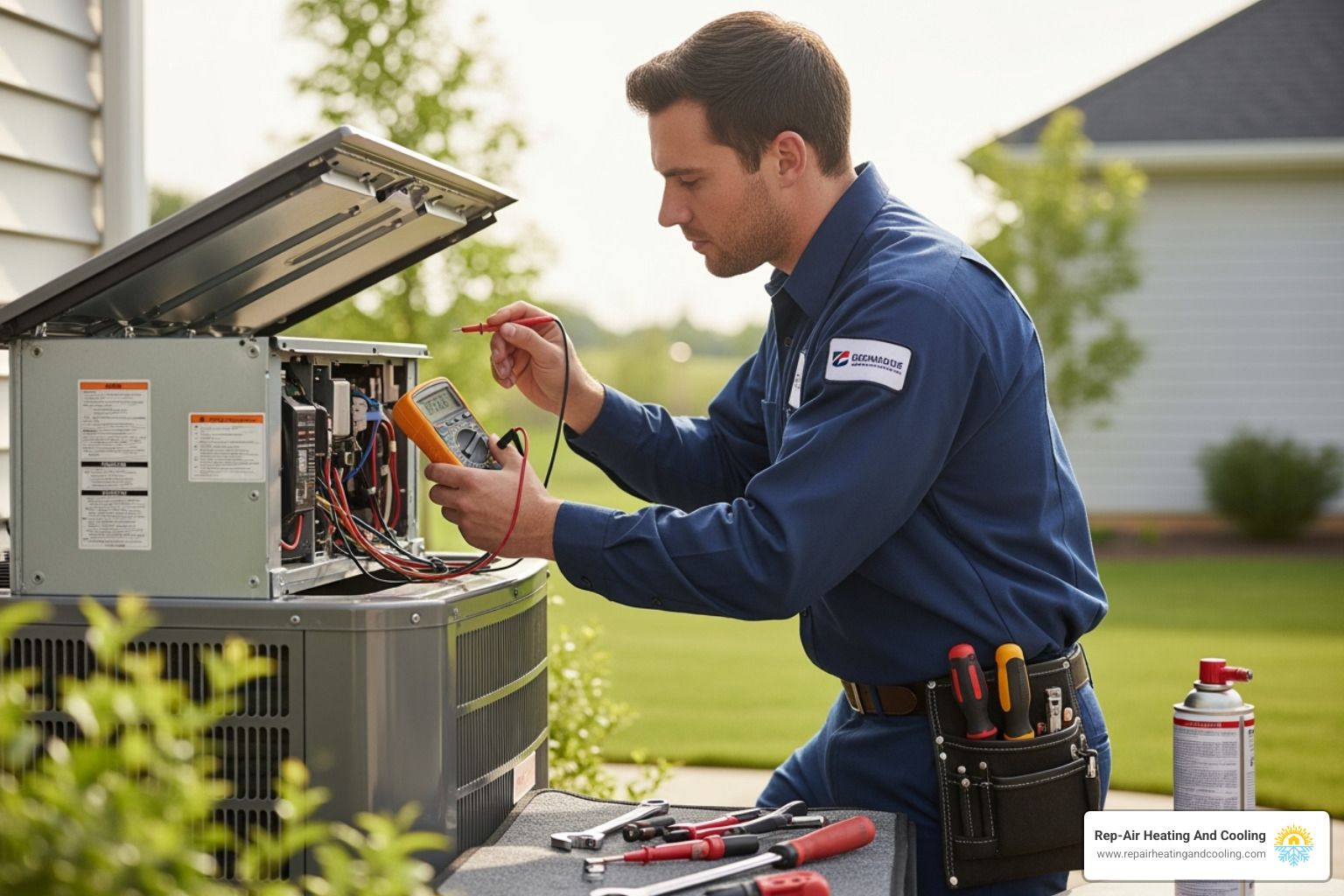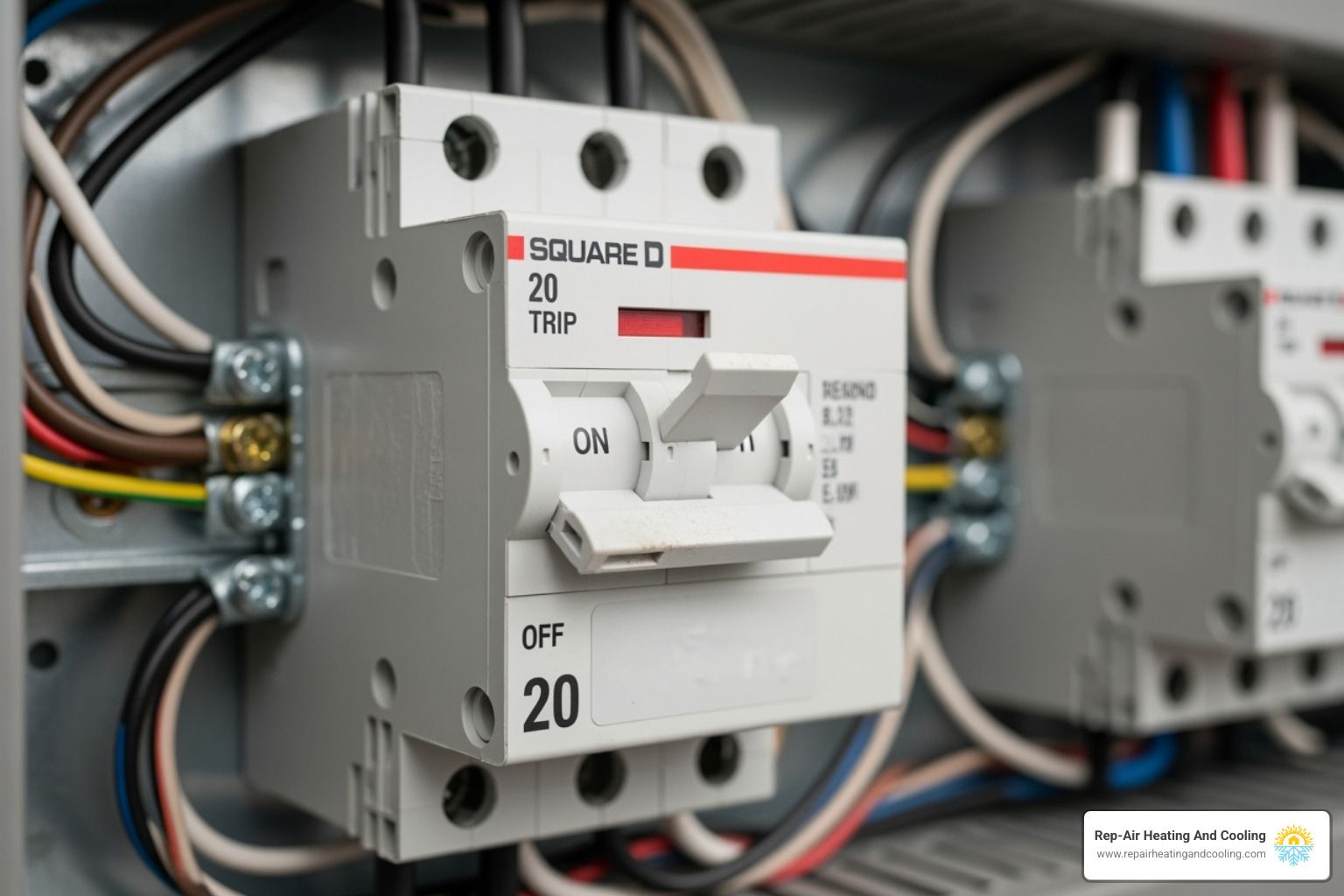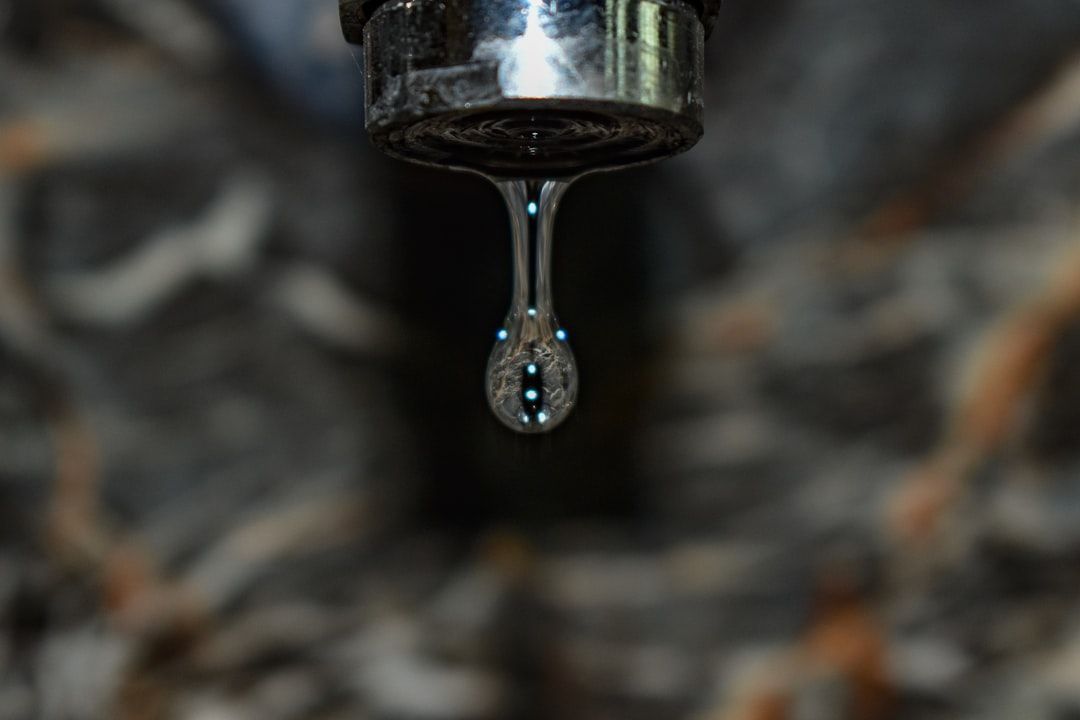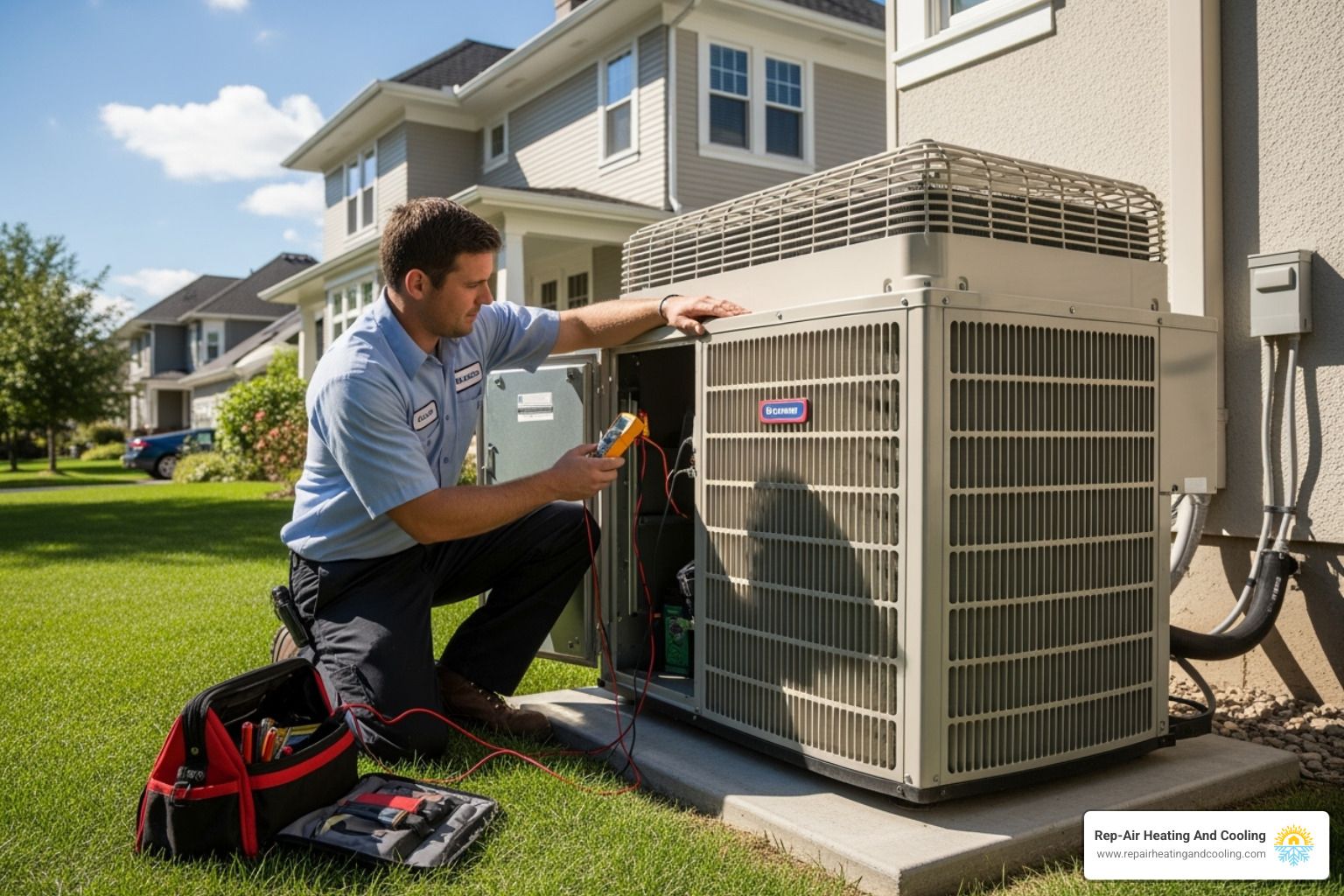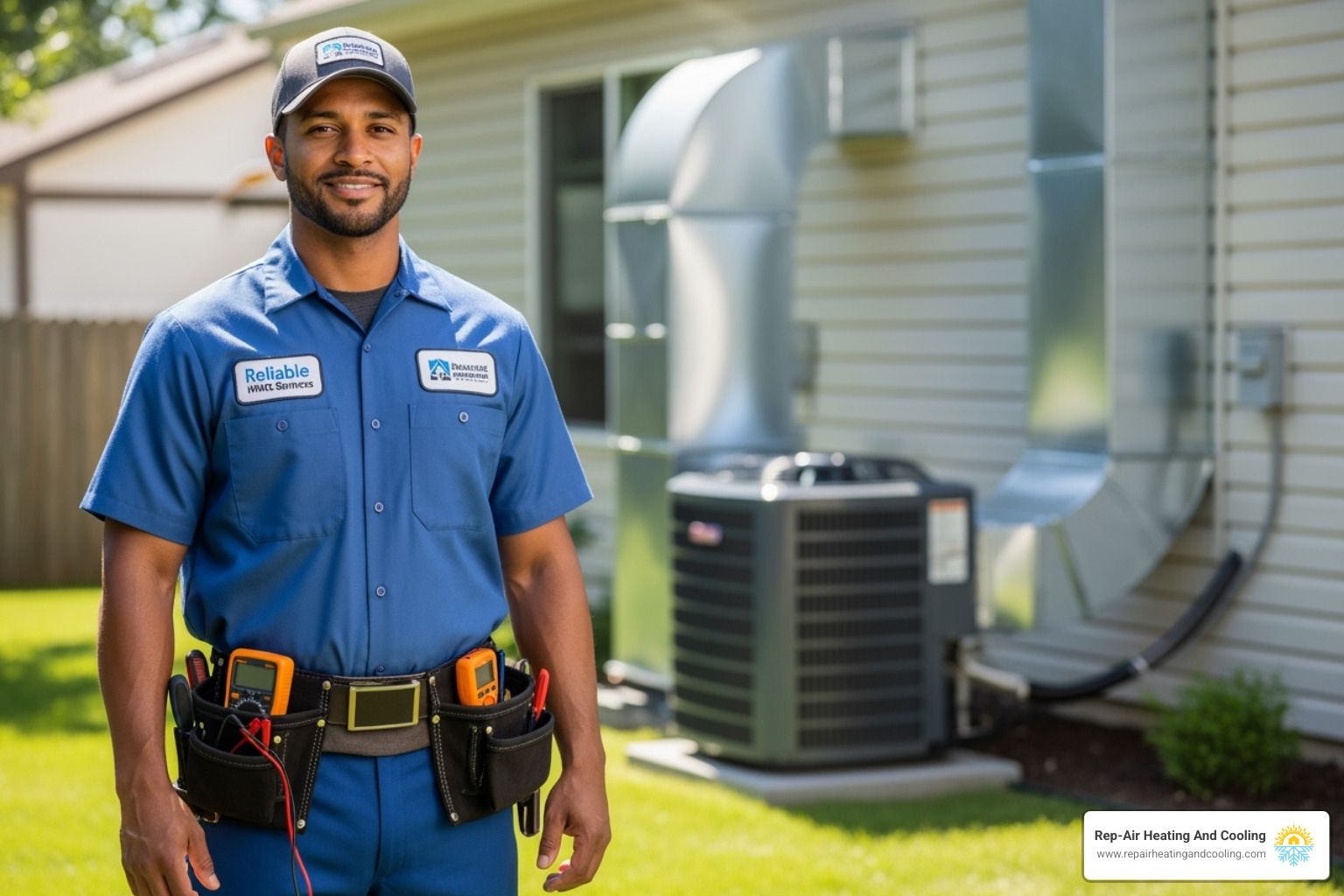The DIY Guide to Preventative Furnace Maintenance
IMPORTANT NOTE: . Our company is located in British Columbia, Canada. If you are reading this article in another location, we hope you enjoy the information, but unfortunately we cannot service you.

Table of Contents
ToggleWhy Preventative Furnace Maintenance is Your Home’s Best Friend
Preventative furnace maintenance involves regular inspections and upkeep tasks that keep your heating system running safely and efficiently. Here are the essential tasks you can do yourself:
- Replace air filters every 1-3 months
- Clean vents and registers to ensure proper airflow
- Clear the 3-foot area around your furnace
- Test your thermostat and safety detectors
- Schedule annual professional service for complex components
With an average temperature of 32.2 degrees Fahrenheit in winter, most people can’t survive without a working furnace. Yet many homeowners forget about their heating system until that first chilly night when they flip the thermostat and… nothing happens.
Regular maintenance prevents these surprise breakdowns. It also keeps your energy bills low, extends your furnace’s lifespan by up to 10 years, and protects your family from safety hazards like carbon monoxide leaks.
The good news? Many essential maintenance tasks are simple enough for homeowners to handle. You don’t need special tools or technical expertise to change a filter or clear debris from vents.
This guide walks you through everything you can safely do yourself, plus when to call in the professionals. You’ll learn which warning signs demand immediate attention and how to keep your Lower Mainland home warm and safe all winter long.
Why Annual Furnace Upkeep is Non-Negotiable
Life in the Lower Mainland is busy, but when the first chill arrives, preventative furnace maintenance becomes essential. It’s the foundation of a safe, comfortable, and affordable heating season. Just as you wouldn’t drive a car for years without an oil change, your furnace needs the same attention to keep your family warm.
The Money-Saving Magic of Energy Efficiency
Heating and cooling can account for over half of your annual energy costs. A furnace with dirty filters or dusty components works overtime, straining to do its job and burning more fuel. Regular maintenance ensures your system runs efficiently, leading to consistent performance and lower utility bills.
Safety First: Protecting What Matters Most
Furnaces burn fuel, which can produce carbon monoxide—a deadly, odorless gas. A small issue like a cracked heat exchanger can become a serious health hazard. Professional maintenance catches these problems early, ensuring your furnace vents properly. Neglected furnaces also pose fire hazards from frayed wiring or dust buildup. Annual upkeep provides peace of mind that your system is operating safely.
Getting More Years from Your Investment
A furnace can last 15 to 20 years with proper care, but neglect can cut that lifespan in half. Annual tune-ups can add five to 10 years to your furnace’s life, delaying the major expense of a full replacement. A well-maintained furnace also delivers improved home comfort with consistent, even heating.
Breathing Easier with Better Air Quality
Your furnace circulates air throughout your home. Regular filter changes trap dust, pet dander, and pollen, which is crucial for family members with allergies or respiratory complications. Clean filters mean better indoor air quality and a healthier home environment. The importance of keeping your HVAC equipment maintained is about protecting your family’s well-being year-round.
Your Essential DIY Preventative Furnace Maintenance Checklist
While professional tune-ups are absolutely essential, there are several important preventative furnace maintenance tasks that you can tackle yourself. Think of these as the basic care your furnace needs between its annual check-ups—like brushing your teeth between dental visits!
The best part? These DIY steps don’t require any special technical skills or fancy tools. Most homeowners can complete them in under an hour, and the peace of mind you’ll gain is priceless. Plus, staying on top of these simple tasks can prevent small issues from turning into expensive emergencies.
Safety First!
Before you even think about touching your furnace, let’s talk safety. This isn’t the time to cut corners or rush through steps. Always turn off the electrical power to your furnace at the circuit breaker first. This prevents the system from accidentally kicking on while you’re working, which could be dangerous.
If you have a gas furnace, you’ll also need to turn off the gas supply. Look for the shut-off valve on the gas line leading to your furnace—it should turn to the “off” position easily. This simple step eliminates any risk of gas leaks while you’re doing your maintenance work.
Once you’ve secured both the power and gas (if applicable), you’re ready to dive into your fall HVAC tasks you should be doing this season. Taking a few extra minutes for safety now can save you from serious problems later.
1. Inspect and Replace the Air Filter
Changing the air filter is the most important task for preventative furnace maintenance. It’s a simple, quick job that any homeowner can do to keep their system healthy.
Location and Size
Most filters are in a slot on the side of the furnace or where the return air duct connects to the unit. Your owner’s manual can show the exact location. The filter’s dimensions (e.g., 20x25x1) are printed on its frame. Always buy the exact same size for a proper fit.
Replacement Frequency
For a pet-free home, replace your filter every 90 days. With one pet, change it every 60 days. If you have multiple pets or family members with allergies, change it every 20-45 days.
The best practice is to check your filter monthly. If you can’t see light through it, it’s time for a new one. A clogged filter is a leading cause of furnace breakdowns, as it forces the system to work harder, increasing energy bills and straining components.
Airflow Direction
The arrows on the filter’s frame indicate the direction of airflow. They need to point toward your furnace to ensure it works correctly.
For more helpful tips like these, check out our furnace maintenance tips to keep your system running like a champ all season long.
2. Clean Vents and Check Airflow
Think of your home’s vents as the delivery system for all that warm air your furnace is working so hard to produce. When these pathways get clogged or blocked, it’s like trying to drink a thick milkshake through a pinched straw – everything has to work much harder for disappointing results.
The good news is that cleaning your vents is one of the easiest preventative furnace maintenance tasks you can tackle. Start by taking a walk through your home and locating all your registers (those are the vents where warm air flows out) and return air grilles (where air gets pulled back into your furnace system).
Vacuuming and Removing Obstructions
Armed with your vacuum cleaner and a brush or crevice attachment, you’re ready to become a vent-cleaning hero. Gently vacuum out any dust, pet hair, lint, and debris that’s accumulated inside the vents and around the grilles. You might be amazed at what comes out – we’ve seen everything from lost socks to forgotten toys emerge from these spaces!
Don’t forget to wipe down the vent covers themselves. A damp cloth works well for removing any stubborn dust or grime that’s built up on the surface.
Furniture Placement
Here’s where a little detective work pays off big time. Walk through each room and check that no furniture, rugs, or curtains are blocking your registers. We can’t tell you how many service calls we’ve been on where the “broken” furnace was actually working perfectly – the problem was simply a couch parked right on top of a vent!
Moving that coffee table a few inches or repositioning a bookshelf can make a dramatic difference in how well your room heats up. When air can flow freely from your vents, you’ll notice more even heating throughout the home and your furnace won’t have to work overtime trying to push air through blocked pathways.
This simple step helps your entire heating system run more efficiently and keeps every corner of your home comfortable all winter long.
3. Clear and Inspect the Area Around the Furnace
Think of your furnace like that friend who needs their personal space to function properly. Just like you wouldn’t crowd someone who’s doing important work, your furnace needs room to breathe and operate safely.
3-Foot Clearance Rule
The three-foot clearance rule isn’t just a suggestion—it’s a safety requirement that could save your home. This means keeping at least three feet of open space around your furnace on all sides. We know basements and utility rooms are prime real estate for storage, but your furnace area isn’t the place for it.
This clearance serves multiple purposes. First, it allows proper airflow around the unit, which helps it operate efficiently. Second, it prevents fire hazards by keeping potential fuel sources away from heat. Third, it gives our technicians easy access when they come for your annual tune-up or if repairs are needed.
Combustible Materials
Here’s where we see homeowners make dangerous mistakes. Never store combustible materials near your furnace. This includes paint cans, cleaning supplies, gasoline, propane tanks, cardboard boxes, old newspapers, or that pile of seasonal decorations you’ve been meaning to organize.
These items can easily ignite if exposed to heat or sparks. Even something as innocent as a stack of old magazines can become a fire hazard. Find another spot for these items—your family’s safety is worth the extra trip to a proper storage area.
Checking for Water Leaks and Rust Signs
While you’re clearing the area, take a few minutes to inspect your furnace itself. Look around the base and sides for signs of water leaks. You might notice puddles, water stains, or damp spots on the floor or walls nearby.
Water around your furnace could indicate several issues: a plumbing leak, problems with the condensate drain (especially common in high-efficiency units), or even issues with your home’s foundation. Don’t ignore these signs—water and heating equipment don’t mix well.
Also keep an eye out for rust signs on the furnace itself. A little surface rust might not be cause for alarm, but significant rusting can indicate long-term moisture problems that could compromise your system’s safety and efficiency. When in doubt, it’s better to have a professional take a look than to risk a bigger problem later.
This simple preventative furnace maintenance step takes just a few minutes but can prevent serious safety hazards and costly repairs down the road.
4. Test Your Thermostat and Safety Detectors
Your thermostat is like the conductor of your home’s heating orchestra, while your safety detectors stand guard against invisible dangers. Taking a few minutes to check both can save you from cold nights and keep your family safe.
Thermostat Settings and Battery Replacement
Before winter settles in, give your thermostat a quick check-up. Make sure it’s programmed for your winter schedule – you might want to lower the temperature when you’re tucked in bed or away at work to save energy. It’s amazing how much you can save just by dropping the temperature a few degrees during times when you won’t notice.
If your thermostat runs on batteries, now’s the perfect time to replace them annually. We can’t tell you how many emergency calls we get where the “broken” furnace just needs fresh batteries in the thermostat! It’s one of those simple things that can leave you scratching your head on a cold evening.
Consider this your friendly nudge to upgrade to a smart thermostat if you haven’t already. These clever devices learn your daily routines and adjust automatically, giving you greater control and efficiency without the guesswork.
Testing Smoke and Carbon Monoxide Detectors
Here’s where we get serious about safety. Your smoke and carbon monoxide detectors are your home’s silent sentinels, working 24/7 to protect your family. Test them monthly by pressing that little “test” button – yes, it’s loud and might startle the cat, but it’s worth the peace of mind.
Make sure you have carbon monoxide alarms on every level of your home, especially in central locations and outside bedrooms. Carbon monoxide is sneaky – it’s completely odorless and colorless, which is why these detectors are so crucial.
Don’t forget to check the expiration dates on your detectors. Most have a lifespan of 5 to 10 years, and when they expire, they need to be replaced immediately. Think of it as a small investment in your family’s safety.
Understanding how to maintain your furnace before the heating season starts goes beyond just comfort – it’s about creating a safe, warm haven for the people you care about most.
When to Call a Professional: Signs and Services
While some preventative furnace maintenance is DIY-friendly, complex components with gas lines and electrical systems require professional expertise. Attempting advanced repairs is dangerous and can void your warranty. Know when to call a professional to keep your family safe and your furnace running smoothly.
Signs Your Furnace Needs Immediate Attention
Recognizing warning signs can prevent costly repairs and dangerous situations. Call a professional if you notice:
- Unusual noises: Rattling, banging, squealing, or grinding sounds indicate mechanical problems, such as loose parts or motor issues.
- Strange smells: A rotten egg odor signals a gas leak. Evacuate immediately and call your gas supplier or 911 from a safe location. Burning or electrical smells suggest overheating and require immediate shutdown and a service call.
- Yellow pilot light or burner flame: The flame should be a steady blue. A yellow or flickering flame indicates incomplete combustion, which can produce carbon monoxide.
- Short cycling: If your furnace turns on and off frequently, it puts excessive wear on the system. This can be caused by an overheating heat exchanger, a clogged filter, or other issues.
Don’t ignore these red flags. Learn more about 5 HVAC problems to prevent in winter to stay ahead of potential issues.
What a Professional Technician Checks
During an annual tune-up, our certified technicians follow a detailed heating tune-up checklist to ensure safe, efficient operation. Key checks include:
- Heat exchanger inspection: We check for cracks or damage that could leak carbon monoxide.
- Burner cleaning and adjustment: This ensures efficient fuel combustion and prevents CO production.
- Blower motor and electrical check: We inspect the motor, lubricate parts, and tighten all electrical connections to prevent failures and fire hazards.
- Gas pressure and safety controls test: We verify correct gas pressure and test all safety systems that shut the furnace down during a malfunction.
- Flue and vent system inspection: We ensure exhaust gases are venting properly and not backing up into your home.
- Thermostat calibration and CO testing: We confirm your thermostat is accurate and use specialized tools to test for any carbon monoxide.
This comprehensive service catches problems early, ensuring your furnace is ready for winter in the Lower Mainland.
Frequently Asked Questions about Furnace Maintenance
Furnace maintenance can seem complex, but we’re here to answer the most common questions homeowners ask.
How often should my furnace be serviced?
Your furnace needs professional service once a year, ideally in the fall before the heating season begins. This allows a technician to catch potential issues before you’re left in the cold. In addition to annual service, perform monthly DIY checks, especially inspecting the air filter. You may need to change filters more often if you have pets or allergies.
Can I void my furnace warranty by not performing maintenance?
Yes, skipping annual maintenance can void your furnace warranty. Most manufacturers require proof of regular professional service to keep the warranty valid. Documentation is key, so keep detailed records of all maintenance and repairs. This paperwork is crucial if you ever need to file a warranty claim.
What’s the most important DIY furnace maintenance task?
The single most important task is changing your air filter regularly. A clogged filter restricts airflow, forcing your furnace to work harder. This leads to higher energy bills, increased strain on components, and potential system failure. Regularly changing your filter is the easiest way to prevent common furnace problems and keep your system running efficiently.
Keep Your Home Warm and Safe This Winter
Winter in the Lower Mainland can be unpredictable, but your home’s comfort doesn’t have to be. Throughout this guide, we’ve walked you through the essential steps of preventative furnace maintenance – from the simple monthly task of checking your air filter to recognizing those warning signs that mean it’s time to call in the experts.
The key takeaways are straightforward: regular maintenance saves money, extends your furnace’s life, and most importantly, keeps your family safe from dangers like carbon monoxide leaks and fire hazards. These aren’t just nice-to-have benefits – they’re the peace of mind that comes from knowing your heating system won’t let you down when you need it most.
We understand that maintaining your furnace might seem overwhelming at first, but you don’t have to do it alone. The DIY tasks we’ve covered – changing filters, cleaning vents, clearing the furnace area, and testing your thermostat and detectors – are all manageable with a little time and attention. For everything else, professional support is just a phone call away.
At Rep-Air Heating And Cooling, we’ve been treating our customers like family across the Lower Mainland for years. Whether you’re in Mission, Abbotsford, Langley, Surrey, or anywhere else in our service area, we’re here to support you with comprehensive maintenance plans and best customer service.
Don’t wait until that first frosty morning when your furnace decides to take an unexpected vacation. Take action now, while the weather is still mild and you have time to address any issues without the pressure of a cold house.
Ready to give your furnace the professional attention it deserves? Schedule your professional furnace tune-up in Mission today, and let us help you enjoy a warm, safe, and worry-free winter season ahead.
Request your service today!
Our team of highly trained technicians are standing by ready to help you out with all of your service, repair, and installation needs. You can count on us for on-time repairs, professional installation, and the friendliest customer service in town!Contact Rep-Air Heating & Cooling today to get started with service by requesting a quote online, or by phone at (844) 218-3362.
Request Service
Contact us today to request an estimate or schedule service.





